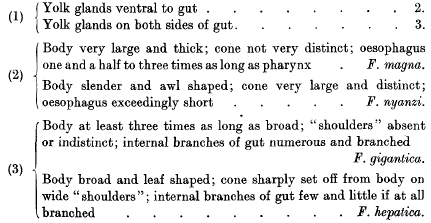Article contents
A Revision of the Genus Fasciola. With particular reference to F. gigantica (Cobbold) and F. nyanzi (Leiper)
Published online by Cambridge University Press: 06 April 2009
Extract
1. The specimens in the material here dealt with make a series of forms connecting F. angusta (Railliet) and F. aegyptiaca (Looss).
2. No important character separates any of these flukes from F. gigantica (Cobbold) and they must accordingly be all identified with this species.
3. The following key represents the simplest method of distinguishing between the species of Fasciola at present described. (For detailed diagnoses see the literature referred to below and this paper.)

- Type
- Research Article
- Information
- Copyright
- Copyright © Cambridge University Press 1921
References
LITERATURE
Stiles, C. W. (1894–1895). The anatomy of the Large American Fluke. Journ. Comp. Med. and Vet. Arch. xvi. 139.Google Scholar
Railliet, M. A. (1895). Sur une forme particulière de Douve hépatique provenant du Sénégal. Comp. rend, des séances de la Soc. de Biol., Mai.Google Scholar
Looss, A. (1896). Recherches sur la Faune parasitaire de l'Egypte. lère Partie. Mém. de l'Institut Egyptien, iii. 1–252. Pl I–XVII.Google Scholar
Blanchard, R. (1896). Parasites Animaux, in Bouchard, Traité de Pathologie générate, ii. 733–734.Google Scholar
Stiles, C. W. (1898). Flukes and Tapeworms of Cattle etc. with special reference to the inspection of meats. Bureau of Animal Industry, Washington.Google Scholar
Looss, A. (1902). Über neue bekannte Trematoden aus Seeschildkröten. Zool. Jahrb., Jena. Abt. f. Syst. v. 16 (3–6), 24 Nov., 781–783.Google Scholar
Leiper, R. T. (1910). The Entozoa of the Hippopotamus. Proc. Zool. Soc., 02. 1st, 237–238.Google Scholar
Goddard, F. W. (1919). Fasciolopsis buski. Journ. of Parasitology, v, no. 4, 06, 141–163.CrossRefGoogle Scholar
- 15
- Cited by


